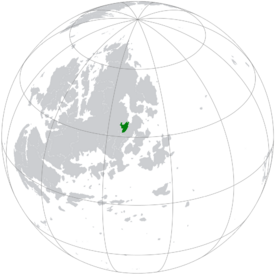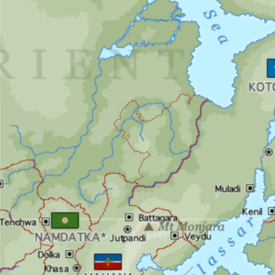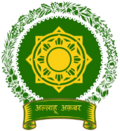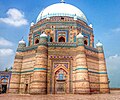Zekistan
Salamid Republic of Zekistan ਜ਼ੈਕਿਸਤਾਨ ਗਣਰਾਜ (Zekistani) | |
|---|---|
 Location of Zekistan | |
 Map of Zekistan | |
| Capital | Manzarabad |
| Largest | Sulhid |
| Demonym(s) | Zekistani, Zeki |
| Government | Federal Salamic presidential-parliamentary republic |
| Abbaad Sumbal | |
| Abdul Majeed Gabol | |
| Area | |
• | 122,176.09 km2 (47,172.45 sq mi) |
| Population | |
• Estimate | 12 million |
This article or section is in the process of an expansion or major restructuring. You are welcome to assist in its construction by editing it as well. If this article or section has not been edited in several days, please remove this template. If you are the editor who added this template and you are actively editing, please be sure to replace this template with {{in use}} during the active editing session. Click on the link for template parameters to use.
This article was last edited by Orioni (talk | contribs) 27 days ago. (Update timer) |
Zekistan, officially known as the Salamid Republic of Zekistan, is a sovereign state in Oriental Europa on Eurth. It is bordered by NEIGHBOURINGNATION to the north, Kotowari in the east, Mahana to the south, and NEIGHBOURINGNATION in the west. The country is approximately 122,176.09 square kilometres (47,172.45 sq mi) in size and home to 12 million Zekis.[1] Manzarabad is the capital, while Sulhid is the largest city.
Zekistan is a federal republic with a presidential-parliamentary system. The country enjoys a unique legacy of both Salamid and Buranian cultural influences. President Abbaad Sumbal is the current head of state, representing the country internationally. Prime minister Abdul Majeed Gabol serves as head of government, overseeing day-to-day administration.
Zekistan is a developing country with a mixed economy that is characterized by a mix of agriculture, manufacturing, and services sectors. It receives support from foreign aid from international organizations and other countries. Since the aftermath of the Zekistani War, the Assembled Nations deployed peacekeeping forces to the region to maintain stability and prevent further violence.
Etymology
(WIP. Where does your country's name come from? Most RL national names come from a small variety of choice. Some examples: land of a tribe (ex. France, Persia, Mongolia, Russia), characteristic geography (ex. Netherlands, India, Morocco), an old ruler or religious figure (ex. Philippines, San Marino, Europa, Saudi Arabia), the Latin description of a place (ex. Australia, Argentina, Liberia). How is the name pronounced? How is the name translated into other languages?)
The name Zekistan is a variant of Zakiastan or Shakyastan, meaning the “Kingdom of the Shakya.” It is possible that these variations of the name “Shakya” developed over time as the name was passed down through different cultures and languages.
The etymology of the name “Shakya” is uncertain, and there are a number of theories about its origins. One theory is that the name is derived from the Old !Persian wo“d "sa”a," which mea“s "nom”d." This is supported by the fact that the Saka were a nomadic people who lived in central Burania. Another theory is that the name is derived from the !Sanskrit wo“d "sa”a," which mea“savage”ge" “r "barbari”n." This theory is supported by the fact that the Saka were often described as fierce warriors in ancient texts. A third theory is that the name is derived from the !Avestan wo“d "sa”a," which mea“s "mo”k." This theory is based on the fact that the Saka were known for their Phosattist practices and their involvement in the spread of Phosattism in central !Asia.
Geography
(WIP. Landscape. Climate. Where exactly is your country compared to others on the global map? Describe the landscape, plants, and animals. Which mountains and rivers are important to include? Describe are the climate and seasons? How does geography determine where people live? Are there areas separated from one another? How about cities? This will greatly help you with the next part of history.)
- Eastern end of the Amutian desert, but also part of the Orient.
- River delta.
- Jasmine Sea.
- Shares a long border with Kotowari in the southeast, along the $riverName river.
- Share a short border with Mahana in the southwest.
Cities
- Manzarabad is the capital.
- Sulhid is the largest city.
History
(WIP. How did your current country come to be? What were the country's previous incarnations? Was the country part of a union with a neighbour? Which events shaped the way the country is today?)
- Prehistory — First people move in from the east. Area quickly populated by the same or similar people who live in the big river delta to the north.
- Classical Age
- Used to be part of Shakya realm. The name is a partial reference to “Zakiastan” or “Shakyastan.”
- In the aftermath of the Buranian withdrawal, the Shakyan tribe managed to fill the power vacuum in the region. They consolidated their control over many of the other local tribes and petty kingdoms, and formed the first large state.
- Does the Pearl Road reach this far?
- Post-classical Era —
- Modern Age.
- 20th century — Increased globalisation.
- 21st century
- Great Europan Collapse;
- Zekistani War.
- Post-conflict peacekeeping.
Zekistani War
| Zekistani War | |||||||
|---|---|---|---|---|---|---|---|
| Part of Great Europan Collapse | |||||||
| |||||||
| Belligerents | |||||||
| Commanders and leaders | |||||||
|
| |||||||
| Strength | |||||||
|
50,000 Zekistani military 15,000 $Terrorist militia | 30,000 troops | ||||||
| Casualties and losses | |||||||
|
xx,xxx Zekistani forces x,xxx EOS forces 23,000 civilians dead 12,000 civilians unaccounted | |||||||
The War in Zekistan was a conflict that took place from 2006 to 2009 in the Oriental region of Europa. The war was fought between Zekistani government forces, various separatist and Salamic militant groups on one side, and the Entente of Oriental States on the other side. It was part of the larger event known as the Great Europan Collapse. The fighting lasted for several years and resulted in significant loss of life and destruction in the region.
WIP timeline:
- 2006
- April–May. A dramatic wave of terrorist attacks sweeps Southeast Europa, particularly targeting EOS interests. After months of intense searching, EOS intelligence has tracked the source of the attacks to the small Oriental nation of Zekistan.
- June–July. EOS-led operations elsewhere have forced rebels and loyalists to flee. They seek refuge in the nation of Zekistan by invitation of the nation's dictator, Mohammad Morad Tyrak. His tyrannical regime housed death camps and training centres for the terrorist networks, and promoted cleansing of the ethnic Zeki population. He declared his intention to establish a great Salamic state in the region.
- August–September. The Zekistani government responded by sending in government troops to support the rebels.
- October–November. Various failed diplomatic solutions and repeated warnings by the Assembled Nations.
- December. After confirmed reports of ethnic cleaning and terrorist sponsorship by dictator Mohammad Morad Tyrak, EOS voted to invade Zekistan to remove him from power.
- The war began in December 2006, when Kotowari granted EOS access through its airspace. Two aircraft carriers launched aircraft to airstrike Tyrak's air, armour, and bases across the nation.[a] For 72 hours, EOS forces launched air strikes against Zekistan air defences, radar, communications, and armour.
- December 24, 2006 – 05:00 hrs. Under the cover of darkness, the EOS-led forces from $number different countries began to land along the coast.
- When the dust settled, infantry and armour converged on the coastal city of Sulhid. When they arrived Zekistan, their first objective is to help secure the airfield, the main airport in the city. However, the route to the airport is crawling with resistance. The first few days after they arrived, they were ambushed. Despite a resounding victory against Tyrak's regime, 38 EOS personnel were confirmed KIA in the first 72 hours of fighting. Eight are listed as MIA.
- 2007
- January–June. Zekistani counterattack. Back and forth. The conflict quickly escalated into a full-scale war along multiple fronts.
- August. But EOS is more powerful and modern. Zekistani government lost control.
- September. Capital captured.
- Manzarabad International Airport is secured for EOS use.
- After the Airport is successfully captured, $SpecialForcesName is tasked with infiltrating Tyrak's palace and eliminating him. They trek through the city and make it to the palace. While they manage to capture one of Tyrak's top lieutenants, Tyrak escapes. The members of $SpecialForcesName also witness one of the Joint STARS planes crashing into the city. The squad is then ordered to rescue the crew of the downed plane before they can be captured by Tyrak's men. $SpecialForcesName secures the crash site, but the crew of the plane is taken hostage by Tyrak's men. $SpecialForcesName, with the assistance of two Ranger snipers, finds and rescues the crew.
- $SpecialForcesName then track Tyrak down and find his SUV in an old train yard. $SpecialForcesName calls in an airstrike on the SUV before it escapes. EOS gunships swoop down and destroy the SUV, eliminating Tyrak. Zekistani dictator Mohammed Morad Tyrak is killed in an air-to-ground missile strike by EOS gunships. DNA testing will later confirm is death, despite fervent denial by his supporters.
- October.
- The first humanitarian relief shipment arrive.
- The younger brother, Colonel Abbaad Tyrak, was presumed to be dead. He assumes the role as ruler. He is willing to work towards democracy and stray away from his father and brother's tyrannical regime.
- Over 23,000 ethnic Zekis are found in mass grave sites scattered across the country. Several members of Tyrak's staff are captured and prosecuted for crimes against humanity. An estimated 12,000 civilians are still unaccounted for.
- November. Despite the death of Tyrak, propaganda broadcasts were made by a surviving group of Tyrak soldiers called the Black Wind Brigade, headed by Hamal Tyrak, one of Tyrak's sons. As a way of repaying the Army Rangers from Mike 25 a debt for saving them in a car park, both Alpha and Bravo team from $SpecialForcesName were “on loan” to them to participate in unofficial assignments. In the first mission, both teams were to mark a radio tower for an airstrike to end the propaganda broadcasts. On the second epilogue mission, both fire teams, with assistance from Staff Sergeant Hackett, were sent to a mosque to take out the Black Wind Brigade. Hamal Tyrak is killed by an airstrike during a firefight.
- 2008
- Multiple factions emerge.
- March. Six months after the fall of Tyrak's regime, the Assembled Nations has established an interim government to transition Zekistan into democracy. However, severe problems were also emerging. Zekistan has erupted into a sectarian conflict. The warring factions are composed of:
- the Mujahideen Al-Zeki, a Tyrak loyalist group attempting to re-establish the old regime; and
- the Anser Al-Ra’id, a northern ethnic Zeki faction seeking independence of the province of Tien Hamir under his rule.
- April-May. The previously peaceful province and its regional capital city, Khardiman, became a focus of the fighting in the country when Mujahideen forces staged an uprising. This brought them into conflict with EOS forces, AN peacekeeping forces, and National Militia forces under the control of regional governor Andrei Zakirov and the Anser Al-Ra’id forces.
- During the beginning phases of the uprising, an Imperial Orinese Army squad led by Sergeant !Brian Sims and Sergeant !Hyde were assigned to take the Tien Hamir Bridge. However, Sergeant Daniels requests their aid while heading for the bridge. Both fire teams help Daniels provide aid to his men and repel the insurgency in his assigned post before storming the Art Center and taking control of the bridge. Meanwhile, Daniels leads a squad of men to raid local boathouses to destroy the weapons supply ring. The Orinese Army requests Daniels' aid in destroying artillery cannons located in the local Parliament building. Despite the destruction of one artillery cannon, Orinese Army captain Smithson orders an airstrike on the Parliament building, crippling Daniels' squad. With his men scattered and wounded, Daniels rallies isolated teams of soldiers to commandeer a bus to transport the wounded for a medical evacuation. Shortly after securing the bus, Daniels' newly formed team travels through Al Ra'id territory to reach the Tien Hamir Monastery. Upon hitting the monastery, a CH-47 Chinook arrives to extract the wounded in the gardens. However, the threat of an RPG-wielding insurgent threatens the safety of his men, prompting Daniels to kill the insurgent and sacrificing his life to defend the evacuating soldiers from Al Ra'id forces. Meanwhile, a veteran squad led by Sergeant Santiago Mendez defends their patrol area from Al'Raid forces before being re-assigned to rescue Daniels. Mendez's team fight their way to the monastery, but arrive too late, recovering Daniels' corpse. Daniels was posthumously awarded the Silver Star for his heroic actions.
- June-September. To make matters worse, Anser Al-Ra’id forces soon turn on EOS, AN and National Militia forces. But Orinese forces were able to re-take the Tien Hamir Bridge from insurgent control and EOS forces were able to re-take most of the city, halting a possible civil war between the Mujahideen, Al-Ra’id forces and the Zekistani government. At the centre of the conflict is Sergeant Eric Daniels, a well-intentioned soldier who abandoned his post during the uprising and is seeking redemption for his past mistakes.
- 2009
- Ultimately, the !rebels were either captured or killed.
- The war officially ended on Friday, 22 May 2009.[b]
- In the aftermath of the war, the Assembled Nations deployed peacekeeping forces to the region to maintain stability and prevent further violence. These peacekeepers were able to help reduce tensions and promote peace, but the situation in the Zekistan remained fragile for many years.
Politics
Government
Zekistan is a federal republic with a presidential-parliamentary system, where the president serves as head of state, representing the country internationally, and the prime minister serves as head of government, overseeing day-to-day administration. The president is elected by the people and the prime minister is appointed by parliament, often from different parties, with the president having limited domestic policy influence. The prime minister leads the government, working with parliament to pass legislation and set policy, similar to a parliamentary system but with the addition of a president as head of state. Multiple political parties exist, with the party or coalition winning the most parliamentary seats typically forming the government. The parliament, made up of elected representatives, creates laws and sets policy, while the judicial branch interprets and enforces laws, based on a mix of civil and criminal law and with courts at both national and local levels.
Foreign relations
Zekistan is a member of various international organisations, such as the Assembled Nations (AN). These organisations provide a forum for countries to cooperate on issues such as international peace and security, trade, and development. Zekistan maintains embassies in other countries, representing its interests and providing consular services to citizens, and has relationships with a range of countries based on shared history, culture, and economics. Zekistan also has formal and informal alliances with other countries based on strategic interests or cooperation on defence and security.
Military
The police force maintains law and order, while the armed forces defend against external threats. The armed forces have branches such as the army, navy, and air force, each with specialized units and equipment, and military academies train young men and women to become officers. These academies have rigorous requirements and are competitive. A high-ranking officer, such as a general or admiral, leads the armed forces, with the president as commander-in-chief and the military reporting to the civilian government. Zekistan also has reserves, military personnel available for emergency service.
Economy
Zekistan is a developing country with a mixed economy that is characterized by a mix of agriculture, manufacturing, and services sectors. Agriculture is a crucial part of Zekistan's economy, comprising approximately 22% of the nation's GDP and employing around 44% of the labour force. Wheat, rice, cotton, sugarcane, and various fruits and vegetables are major agricultural products. Zekistan has minerals like copper and gold, but due to ongoing conflict, they have not yet been fully exploited. Zekistan's manufacturing sector is significant, with industries such as textiles, chemicals, cement, and other products. The services sector, including telecommunications, finance, and transportation, plays a significant role in Zekistan's economy. Zekistan's economy receives support from foreign aid from international organizations and other countries.
Demographics
Zekistan is home to 12 million people of diverse ethnicity and religion, predominantly $tribe1, $tribe2, $tribe3, and $tribe4. The country has a mix of social classes, with wealthy, middle, and poor classes. The majority of the population is Salamid, with significant minority populations of $religion2, $religion3, and $religion4. Zekistan has both urban and rural populations, with a larger proportion living in rural areas.
The country has a mix of public and private schools, with education valued for social mobility and economic success, but significant disparities in access to quality education for poorer families. Marriage practices vary, with arranged marriages still common and significant social and cultural expectations, and healthcare in Zekistan includes both public and private systems, but with disparities in access to quality care for poorer families. Zekistan also faces a range of diseases, including common illnesses and serious conditions such as tuberculosis, HIV/AIDS, and malaria.
Culture
Zekistan boasts a long and diverse literary tradition, including genres such as poetry, fiction, and non-fiction. $PersonName was a Zeki poet and intellectual who was a leading figure in the progressive movement in Zekistan. His poetry, which often addressed themes of social justice and political struggle, has been widely translated and is considered to be some of the best in the Zekistani language.
The country is known for its intricate and beautiful artwork, including paintings, sculptures, and textiles. $PersonName was a famous Zeki painter and one of the pioneers of modern Zekistani art, known for his bold, colourful paintings that often depicted scenes from Shakyan mythology and daily life, such as “The Battle of $CityName.”
Zekistan's culture also includes a range of traditional and modern forms of art, entertainment, and music, including theatre, dance, and film, as well as a rich musical history and thriving radio industry. Television is popular in Zekistan, with both local and international programming available. Zekistan's cuisine is diverse, with traditional dishes and flavours, as well as influences from other cultures. Local customs, clothing, and morality vary widely, shaped by cultural and religious traditions, and sports are an important part of the country's culture.
However, there are also many stereotypes and misconceptions about Zekistan's culture, and it is critical to strive to understand and appreciate its complexity and diversity. One such stereotypes describes how all Zekis are poor. While poverty is a significant issue in some parts of the country, it is not accurate to assume that everyone is poor. There is a wide range of economic and social conditions, and many Zekistani are well-educated and successful.
Notes
- ↑ OOC. Do we really need those aircraft carriers? The airplanes could also depart from Tamurin, fly over the Menelassar Bay Sea, and through Kotowaran airspace.
- ↑ OOC. Reference to the weekly Muslim Friday prayer.
References
- ↑ NPC Request: Zekistan (21 December 2022)










